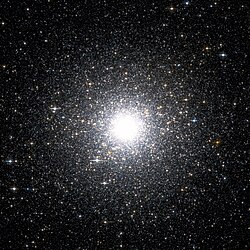Messier 54
| Messier 54 | |
|---|---|
 | |
| Observation data (J2000 epoch) | |
| Class | III[1] |
| Constellation | Sagittarius |
| Right ascension | 18h 55m 03.33s[2] |
| Declination | −30° 28′ 47.5″[2] |
| Distance | 87.4 kly (26.8 kpc)[3] |
| Apparent magnitude (V) | 8.37[4] |
| Apparent dimensions (V) | 12′.0 |
| Physical characteristics | |
| Radius | 153 ly[5] |
| Estimated age | 13 Gyr[6] |
| Notable features | Probably extragalactic |
| Other designations | M54,[4] NGC 6715,[4] GCl 104[4] |
Messier 54 (also known as M54 or NGC 6715) is a globular cluster in the constellation Sagittarius. It was discovered by Charles Messier in 1778 and subsequently included in his catalog of comet-like objects.
Previously thought to belong to our Galaxy at a distance from Earth of about 50,000 light-years, it was discovered in 1994 that M54 most likely belongs to the Sagittarius Dwarf Elliptical Galaxy, (SagDEG),[7] making it the first globular cluster formally thought to be part of our galaxy reassigned to extragalactic status, even if not recognized as such for nearly two and a quarter centuries.
Modern estimates now place M54 at a distance of some 87,000 light-years, translating into a true radius of 150 light-years across. It is one of the denser of the globulars, being of class III (I being densest and XII being the least dense). It shines with the luminosity of roughly 850,000 times that of the Sun and has an absolute magnitude of -10.0.
M54 is easily found on the sky, being close to the star ζ Sagittarii. It is however, not resolvable into individual stars even with larger amateur telescopes.
In July 2009, a team of astronomers reported that they had found evidence of an intermediate-mass black hole in the core of M54.[8]
See also
References
- ^ Shapley, Harlow; Sawyer, Helen B. (1927), "A Classification of Globular Clusters", Harvard College Observatory Bulletin (849): 11–14, Bibcode:1927BHarO.849...11S.
{{citation}}: Unknown parameter|month=ignored (help) - ^ a b Goldsbury, Ryan; et al. (2010), "The ACS Survey of Galactic Globular Clusters. X. New Determinations of Centers for 65 Clusters", The Astronomical Journal, 140 (6): 1830–1837, Bibcode:2010AJ....140.1830G, doi:10.1088/0004-6256/140/6/1830.
{{citation}}: Unknown parameter|month=ignored (help) - ^ Ramsay, Gavin; Wu, Kinwah (2005). "Chandra observations of the globular cluster M54". arXiv:astro-ph/0510217.
{{cite arXiv}}:|class=ignored (help); Unknown parameter|doi=ignored (help) - ^ a b c d "SIMBAD Astronomical Objects Database". Results for NGC 6715. Retrieved 2006-11-16.
- ^ distance × sin( diameter_angle / 2 ) = 153 ly. radius
- ^ Geisler, Doug; Wallerstein, George; Smith, Verne V.; Casetti-Dinescu, Dana I. (2007). "Chemical Abundances and Kinematics in Globular Clusters and Local Group Dwarf Galaxies and Their Implications for Formation Theories of the Galactic Halo". Publications of the Astronomical Society of the Pacific. 119 (859): 939–961. Bibcode:2007PASP..119..939G. doi:10.1086/521990.
- ^ Siegel, Michael H.; Dotter, Aaron; Majewski, Steven R.; Sarajedini, Ata; Chaboyer, Brian; Nidever, David L.; Anderson, Jay; Marín-Franch, Antonio; Rosenberg, Alfred (2007). "The ACS Survey of Galactic Globular Clusters: M54 and Young Populations in the Sagittarius Dwarf Spheroidal Galaxy". Astrophysical Journal Letters. 667 (1): L57-L60. Bibcode:2007ApJ...667L..57S. doi:10.1086/522003.
- ^ Ibata, R.; Bellazzini, M.; Chapman, S. C.; Dalessandro, E.; Ferraro, F.; Irwin, M.; Lanzoni, B.; Lewis, G. F.; Mackey, A. D. (2009). "Density and Kinematic Cusps in M54 at the Heart of the Sagittarius Dwarf Galaxy: Evidence for a 104 M☉ Black Hole?". Astrophysical Journal Letters. 699 (2): L169-L173. arXiv:0906.4894. Bibcode:2009ApJ...699L.169I. doi:10.1088/0004-637X/699/2/L169.
External links
- M54 @ SEDS Messier pages
- Messier 54 on WikiSky: DSS2, SDSS, GALEX, IRAS, Hydrogen α, X-Ray, Astrophoto, Sky Map, Articles and images

